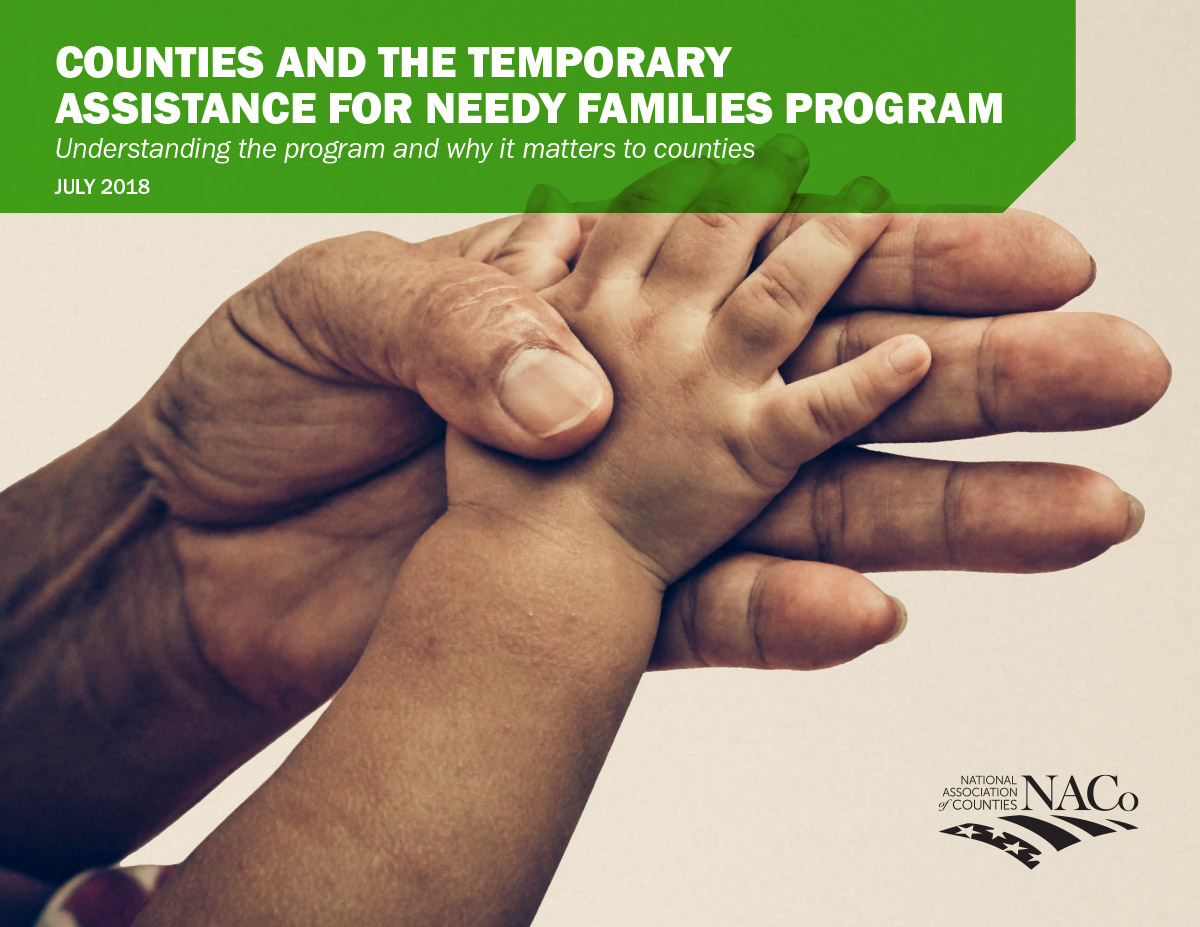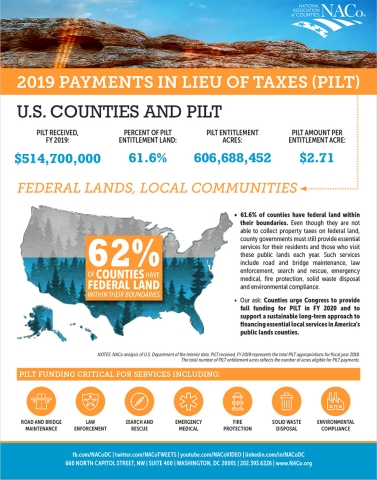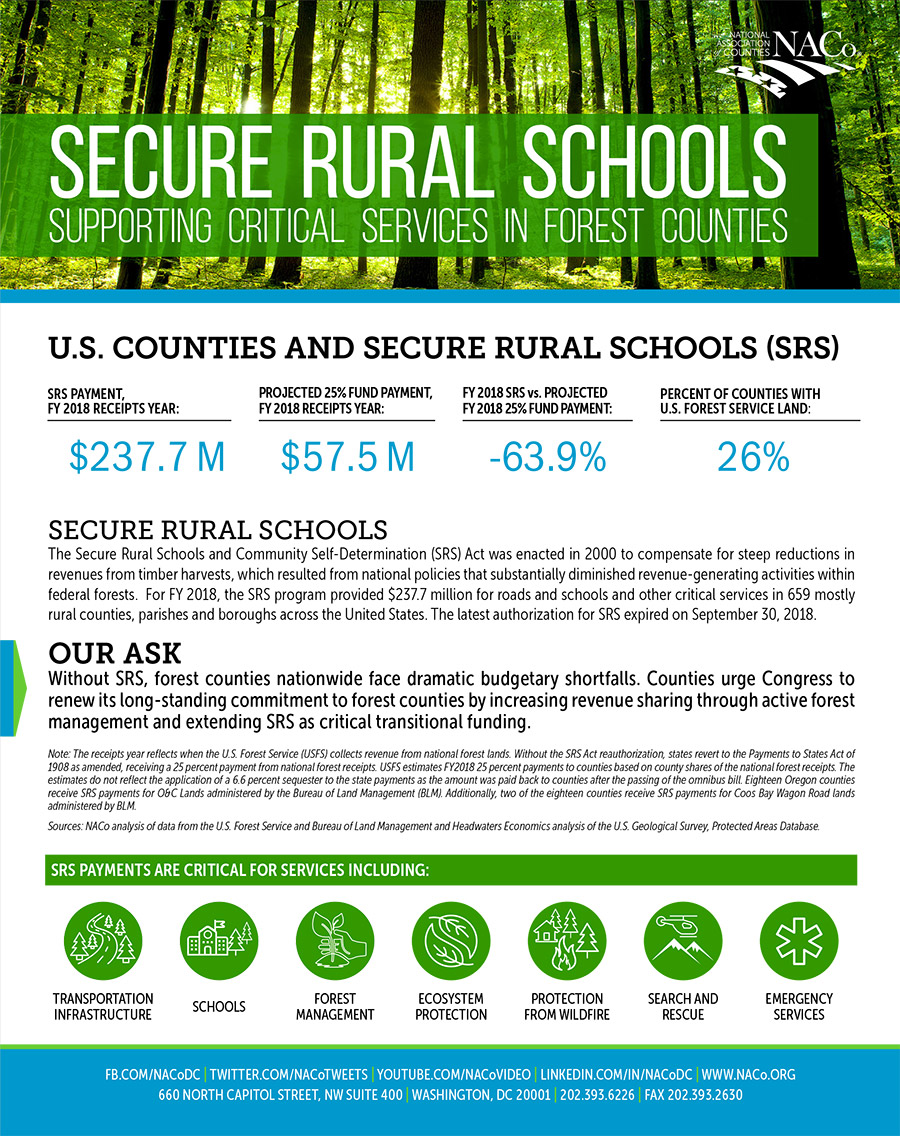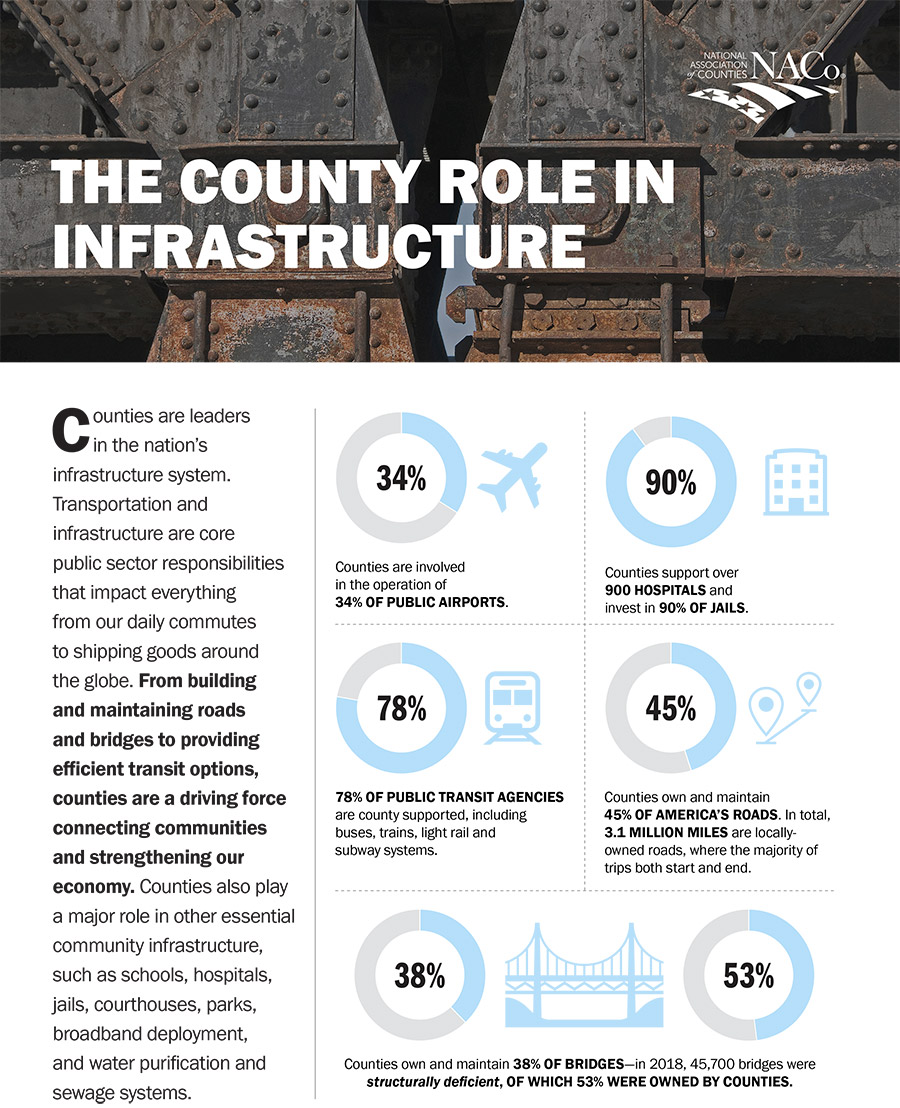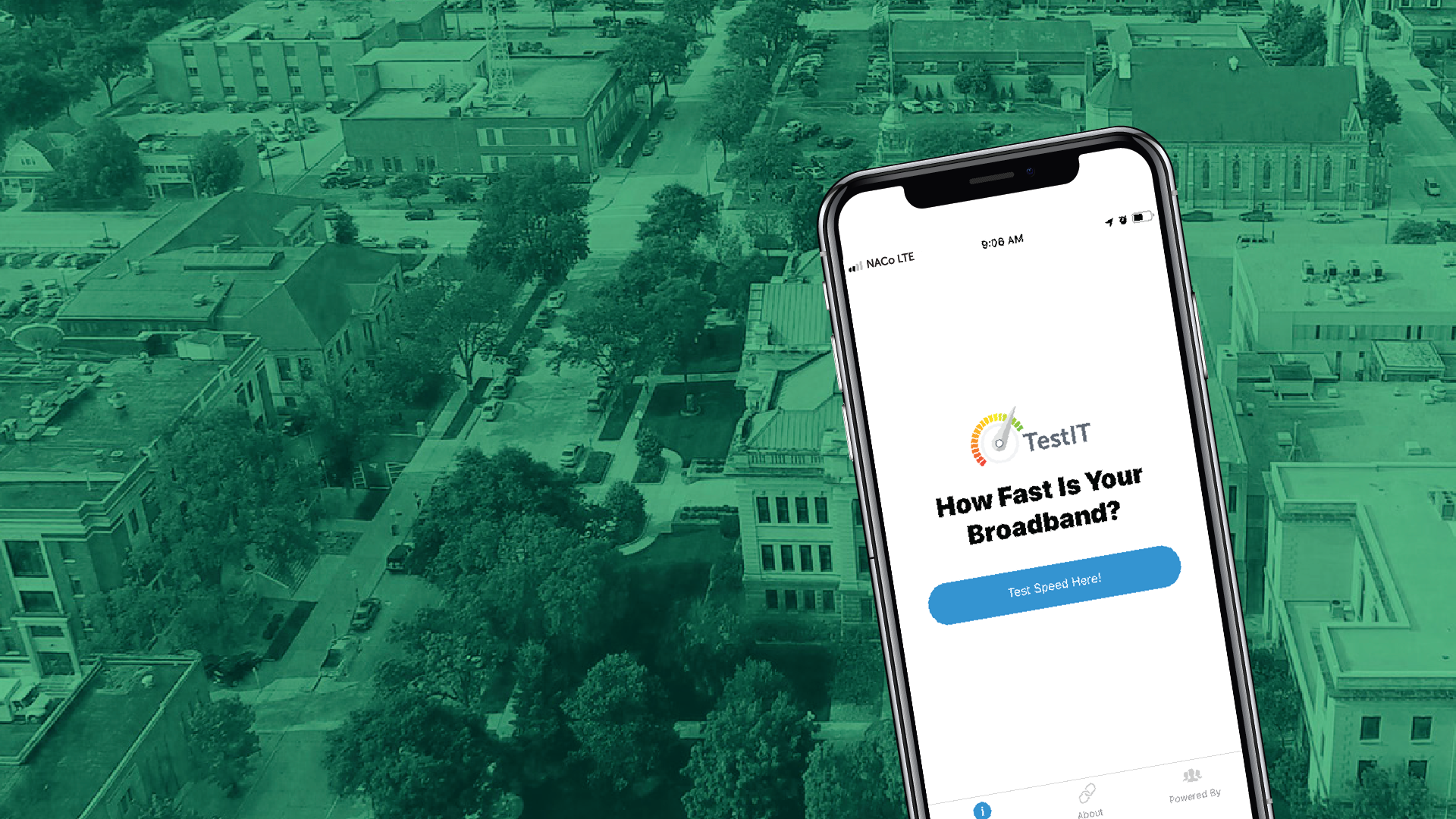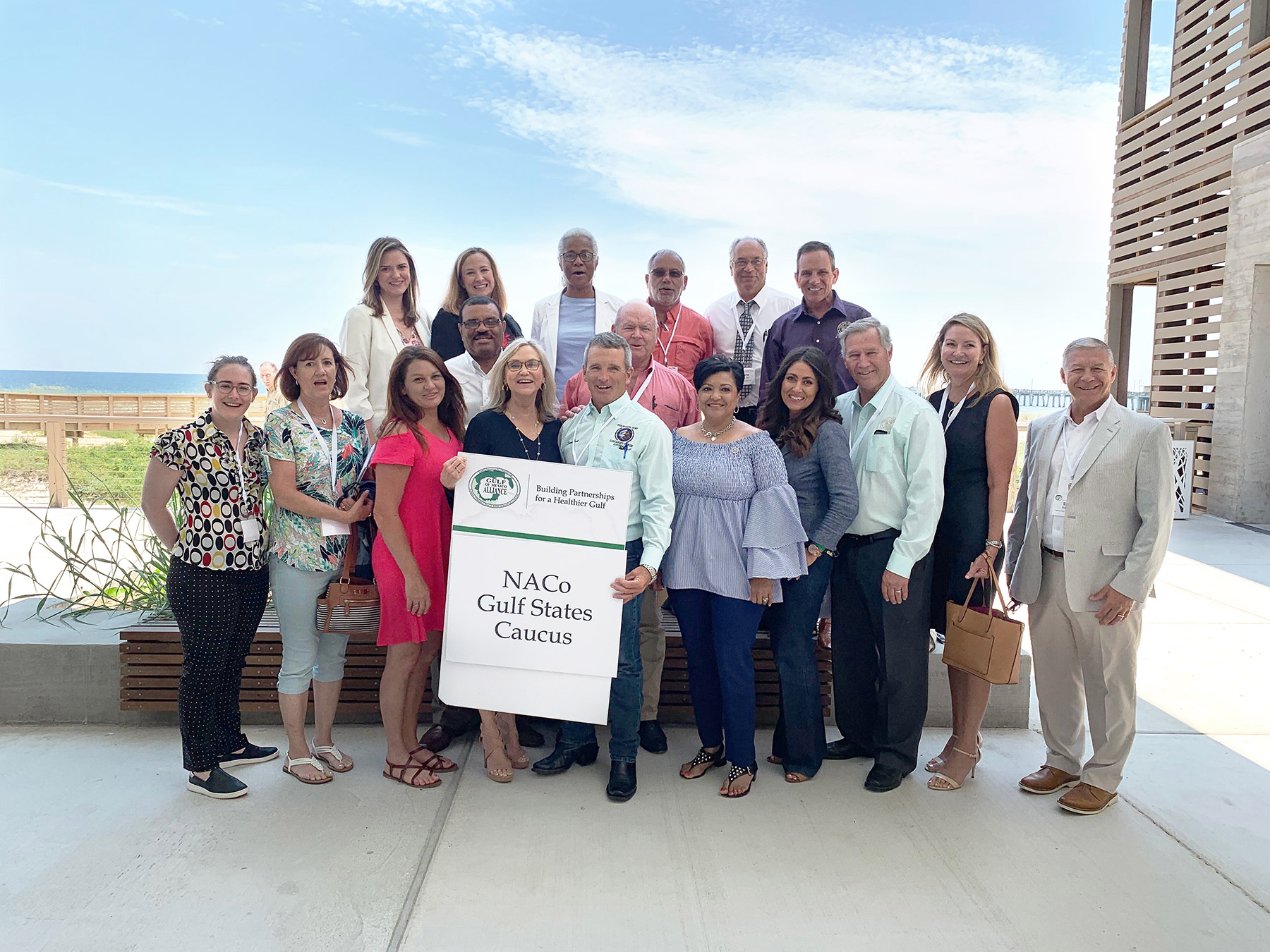2019 Summer Advocacy Toolkit
Upcoming Events
Related News
Advocacy Opportunities and Planning
Through the Labor Day holiday, members of Congress will be back in their home districts for the traditional August recess. This extended break in the federal legislative calendar provides a unique opportunity for county leaders to communicate with members of Congress, demonstrate the impact of your efforts in your communities and advocate for the federal programs that help to strengthen local programs and initiatives.
|
https://www.youtube.com/embed/tFC4QE64E5Y Watch: Summer Advocacy Toolkit Overview |
These opportunities to interact with your representatives and senators are especially critical because they coincide with ongoing negotiations in Congress on major pieces of legislation that directly impact counties. A two-year, $2.7 trillion bipartisan budget deal passed the Senate on July 31 and was signed into law by President Trump on August 2. In the limited days remaining on the federal legislative calendar, lawmakers will next turn their attention toward finalizing FY 2020 appropriations for all federal agencies and programs, develop a surface transportation reauthorization, establish broadband and 5G policies and continue to work towards a long-term reauthorization of the National Flood Insurance Program.
As these negotiations are progressing in Congress, NACo has created this Summer Advocacy Toolkit to aid county leaders in advocating for the programs that matter most to your communities while members of your delegation are in your home states and districts. This toolkit features in-depth information, talking points, media guides and other exclusive NACo materials on county priorities ranging from infrastructure and public lands to health and public safety issues. For additional legislative advocacy materials, including individual policy briefs and presentations, visit
www.naco.org/advocacy.
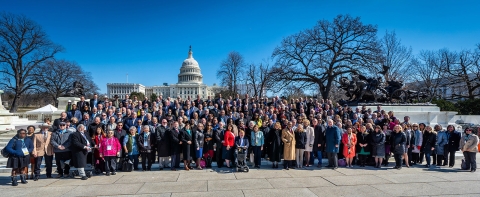
|
County leaders descend on Capitol Hill during NACo’s 2019 Legislative Conference.
Counties Matter Fast Facts
Counties invest over $554 billion annually and employ more than 3.6 million with more than 19,000 elected county board members & elected county executives.
 |
HealthCounties invest $83 billion for community health & hospitals annually supporting over 900 hospitals and more than 100,000 hospital beds. |

|
Justice and public safetyCounties invest $93 billion in justice & public safety services spending almost $26 billion on correctional facilities. Counties invest $35 billion on 3,041 police and sheriff departments. Counties operate 91% of all local jails. |
 |
Economic DevelopmentCounties invest $11 billion for housing and community development and almost $18 billion on parks and recreation facilities, libraries and community centers. |

|
Transportation and InfrastructureCounties build and maintain 46% of America’s road miles and more than 38% of bridges. Counties own or support 34% of public airports and 78% of public transit systems. Counties annually invest more than $122 billion total in building infrastructure and maintain and operating public works and almost $22 billion in sewage and |
Intergovernmental Affairs
Support Improved Federalism Through the Restore the Partnership Act
BACKGROUND
America operates an established form of federalism with multiple layers of checks and balances, including across the three federal branches and between the federal government and state and local governments. While there is a clear distinction and separation of powers and duties among these levels of government, there is also a deep interconnectedness and interdependence. This bond is a shared purpose to achieve public policy outcomes that serve the American public, often requiring the collective efforts of federal, state, local and tribal governments working together.
From 1959-1996, the Advisory Council on Intergovernmental Relations (ACIR) served as the preeminent bipartisan, independent organization in intergovernmental relations. The ACIR produced high-quality information, data and analyses, including over 130 policy reports with action recommendations, 194 information reports and about 80 issues of a widely read magazine titled, “Intergovernmental Perspective.” The Commission also helped develop congressional legislation related to improving the administration of federal grants and it served as a valued advisor to presidents, state leaders and local elected officials. Congress, federal agencies and the White House all depended on the policy input and support of state and local governments to ensure policies were meaningful, impactful and able to be implemented.
COUNTY INTEREST
In recent decades, we have witnessed a significant decline in a structured, intentional dialogue and partnership among federal, state and local government officials. Counties are responsible for a wide range of issues across the country, including maintaining public infrastructure, transportation and economic development assets, providing justice, law enforcement and public safety services and protecting the public’s health and well-being. We also often serve as co-regulators of federal rules, standards and laws with our state and federal counterparts.
While some of these responsibilities are unique to counties, in many cases we work with our state and federal partners to achieve optimal solutions. These responsibilities are the shared, fundamental components of a broader national interest in serving our citizens. Policies and programs established by the federal government are intended to guide and coordinate efforts, but are ultimately implemented at the state and local levels.
|
https://www.youtube.com/embed/FV3rlJfc850 NACo Executive Director Matt Chase testified in support of the bipartisan Restore the Partnership Act on July 23, 2019. |
STATUS
In July 2019, Reps. Gerry Connolly (D-Va.) and Rob Bishop (R-Utah) introduced the bipartisan Restore the Partnership Act (H.R. 3883) to reconstitute and reform the U.S. Advisory Commission on Intergovernmental Relations (ACIR). The purpose of new commission, the Commission on Intergovernmental Relations of the United States, would be to facilitate cooperation and accountability among federal, state, tribal and local governments on both legislation and new regulatory efforts. The new commission would include four seats for county elected officials.
NACo Executive Director Matt Chase testified in support of the legislation on July 23, 2019. Counties are encouraged to urge their senators and representatives to support this important legislation.
Counties also support passage of the Unfunded Mandates Information Transparency Act (UMITA, H.R. 300), which would update the Unfunded Mandates Reform Act (UMRA). While UMRA still serves as a guiding principle for new legislation, over time Congress has found ways to circumvent the law and federal agencies unevenly apply federalism consultation protocols in the rulemaking process. Passing UMITA would address both issues and further strengthen intergovernmental collaboration and the quality of laws and regulations approved by the federal government.
TALKING POINTS
TAKE ACTION
Urge your members of Congress to cosponsor the Restore the Partnership Act (H.R. 3883) and the Unfunded Mandates Information Transparency Act (H.R. 300).
RELEVANT COMMITTEES WITH JURISDICTION (FIND YOUR MEMBER)
- U.S. House Committee on Oversight and Reform
- U.S. Senate Committee on Homeland Security and Government Affairs
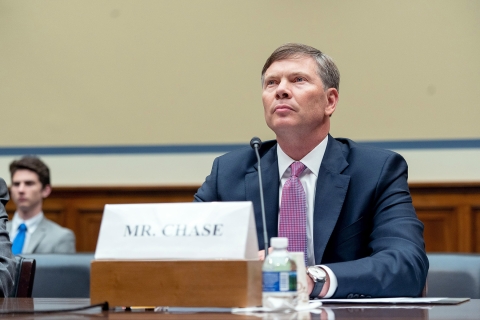
|
NACo Executive Director Matt Chase testifies before the U.S. House Committee on Oversight and Reform Subcommittee on Government Operations on federalism.
Health, Human Services, Justice and Public Safety
Support Legislation to Amend the Medicaid Inmate Exclusion Policy
BACKGROUND
Current federal law prohibits the use of federal funds and services, such as Medicaid and the Children’s Health Insurance Program (CHIP), for health care provided to inmates of a public institution – a category that includes our local jails. The policy, known as the Medicaid inmate exclusion, was originally enacted under the Social Security Act of 1965 and intended to prevent state governments from shifting inmate care costs to federal programs. However, this practice has had an unintended consequence of cutting off federal health benefits to local jail inmates who are awaiting trial.
COUNTY INTEREST
Counties nationwide invest $176 billion annually in community health systems and justice and public safety services, including the entire cost of medical care for all arrested and detained individuals. Counties own and operate 91 percent, or 3,100, local jails that see approximately 10.6 million individuals pass through each year with an average length of stay of 25 days. Although two-thirds of those detained in jails are pre-trial and presumed innocent, current federal law prohibits Medicaid and other federal safety-net programs from paying for their medical care leaving counties responsible for the full cost of inmates’ health care, rather than the traditional federal, state and local partnership for safety-net services. As a result of this federal policy and high occurrences of mental and behavioral health issues and substance use disorders among inmates, county jails are now some of the largest behavioral health care providers in our communities.
STATUS
Congress is currently considering legislation that would amend the Social Security Act to allow pre-trial jail inmates to keep their federal health benefits while awaiting trial – and restore the federal, state and local partnership in funding and delivering health services to justice-involved individuals.
In the U.S. House of Representatives, Reps. Paul Tonko (D-N.Y.) and Michael Turner (R-Ohio) introduced bipartisan legislation, the Medicaid Reentry Act (H.R. 1329), that would restore Medicaid benefits to inmates for the 30-day period prior to their release from jail. Also in the U.S. House, Rep. Alcee Hastings (D-Fla.) introduced the Restoring the Partnership for County Health Care Costs Act (H.R. 1345), which would remove limitations on Medicaid, Medicare, Supplemental Security Income (SSI) and the Children’s Health Insurance Program (CHIP) for pre-trial inmates of jails, detention centers and prisons.
In the U.S. Senate, Senator Ed Markey (D-Mass.) has introduced proposals with NACo’s support in recent months that would improve care coordination for justice-involved individuals by requiring states to suspend – rather than terminate – Medicaid benefits for inmates.
As Congress considers reforms to our nation’s justice system, counties should encourage federal lawmakers to pass legislation that would repeal the Medicaid inmate exclusion and require states to suspend, instead of terminate, Medicaid coverage for justice-involved individuals.
TALKING POINTS
TAKE ACTION
Urge your members of Congress to cosponsor the Medicaid Reentry Act (H.R. 1329) and the Restoring the Partisanship for County Health Care Costs Act (H.R. 1345).
RELEVANT COMMITTEES WITH JURISDICTION (FIND YOUR MEMBER)
Suffolk County, N.Y. Sheriff Errol Toulom, Jr. speaks at NACo’s Capitol Hill briefing on health care in local justice systems.
Support Long-Term Reauthorization of the Temporary Assistance for Needy Families (TANF) Program
BACKGROUND
TANF was created in 1996 and replaced the Aid to Families with Dependent Children (AFDC) program. It is administered by the U.S. Department of Health and Human Services (HHS) and features four program goals: providing assistance to needy families so that children can be cared for in their own homes; reducing the dependency of needy parents by promoting job preparation, work and marriage; preventing and reducing unplanned pregnancies among single young adults and encouraging the formation and maintenance of two-parent families.
As an entitlement to states, TANF is not subject to the annual appropriations process. The program has been funded at $16.5 billion annually since its inception. Last reauthorized in the Deficit Reduction Act of 2005 (P.L. 109-171), TANF expired in 2010 and has since been renewed through a series of short-term extensions.
|
Counties and the Temportary Assistance for Needy Families Program: Understanding the program and why it matters to counties |
COUNTY INTEREST
Serving as the front-line social safety net, counties work to ensure critical welfare services reach those families most in need and help those involved in the TANF program to obtain and maintain employment. Although TANF is a partnership between the federal government and states, ten states delegate TANF administration to county agencies: California, Colorado, Minnesota, New Jersey, New York, North Carolina, North Dakota, Ohio, Virginia and Wisconsin. Additionally, Montgomery County, Maryland operates TANF. Counties in these states contribute significant local funds to the administrative costs of running the program, which cover 51 percent of all TANF recipients.
STATUS
In June 2019, the U.S. Senate cleared bipartisan legislation to reauthorize the TANF program. The bill, (H.R. 2940), which passed the U.S. House of Representatives in June 2019, would extend the program through the end of FY 2019 on September 30, 2019 at current funding levels of $16.5 billion in block grants to states. Consideration of the TANF reauthorization measure follows a short-term extension through June 30 that was enacted following the January 2019 government shutdown. Long-term reauthorization and adequate funding for this safety-net program are critical for counties, which invest over $58 billion annually in human services.
TALKING POINTS
TAKE ACTION
Urge your members of Congress, particularly those who serve on the House Ways and Means Committee, the House Education and the Workforce Committee, the Senate Finance Committee and the Senate Health, Education, Labor and Pensions Committee, to enact a long-term reauthorization of TANF and protect funding for the TANF Contingency Fund.
RELEVANT COMMITTEES WITH JURISDICTION (FIND YOUR MEMBER)
Support Legislation Protecting Medicaid Disproportionate Share (DSH) Hospital Payments
BACKGROUND
Congress established the Medicaid DSH program in 1981 (P. L. 97-35) to ensure that state Medicaid programs provided adequate payments to public hospitals whose patient populations were disproportionately composed of low income Medicaid and uninsured populations. DSH funding is our nation’s primary source of support for safety net hospitals that serve our most vulnerable populations, including Medicaid beneficiaries, the 27 million uninsured and the underinsured. In many states, counties are ultimately responsible for the provision of health care to these groups and rely heavily on the DSH program for support in meeting this mission.
The Affordable Care Act of 2010 (P.L. 111-148) authorized cuts to Medicaid DSH payments under the rationale that the law’s provisions to expand Medicaid would create a vehicle for uninsured patients to purchase health insurance, and thus dramatically decrease the number of uninsured and underinsured. Congress reduced aggregate federal DSH allotments in Medicaid by roughly $18 billion for the period of 2014-2020. However, these reductions have yet to take effect due to numerous pieces of legislation enacted since 2010 that have since delayed the scheduled cuts as projected increases in insurance coverage has not been fully realized.
COUNTY INTEREST
Medicaid DSH payments are critical to local hospitals that serve our nation’s most vulnerable citizens. Hospitals that care for a disproportionate amount of low-income people and uninsured patients incur tremendous uncompensated costs. Medicaid DSH payments aid in making up for those losses and allow our local hospitals to continue to provide high quality care to all patients.
STATUS
While Medicaid DSH cuts have yet to go into effect since implementation of the Affordable Care Act, under current law, if there is no action taken by October 1 of this year, DSH cuts will begin with a $4 billion cut in FY 2020 and increase to $8 billion in FY 2021.
U.S. Representatives Elliot Engel (D-N.Y.) and Pete Olson (R-Texas), have both introduced separate bills aimed at protecting Medicaid Disproportionate Share Hospital (DSH) payments. H.R. 3022 would completely repeal cuts to Medicaid DSH payments and H.R. 3054 would delay impending cuts by two years, as Congress continues to work on a sustainable solution for maintaining the program that enables hospitals that care for a disproportionate amount of low-income and uninsured patients to make up for large uncompensated costs with federal Medicaid dollars.
As Congress works through the FY 2020 appropriations process, counties ask the administration and members of Congress to stop or delay cuts to the Medicaid Disproportionate Share Hospital (DSH) program until a sustainable solution for the preservation of this program is reached.
TALKING POINTS
TAKE ACTION
Urge your members of Congress to pass legislation ahead of the October 1 deadline to prevent Medicaid DHS payment cuts and allow local hospitals to continue to have the resources necessary to provide quality care to our nation’s most vulnerable.
RELEVANT COMMITTEES WITH JURISDICTION (FIND YOUR MEMBER)
Public Lands
Support Full Funding for Payments in Lieu of Taxes (PILT)
BACKGROUND
The PILT program was created in 1976 to offset costs incurred by counties for services provided to federal employees and their families, the public and to the users of public lands. Such services include education, solid waste disposal, law enforcement, search and rescue, health care, environmental compliance, firefighting, parks and recreation and other important community services.
Annual PILT funding levels remained static for many years. For nearly two decades, counties have watched the value of our PILT receipts drop due to inflation. In 1995, NACo was successful in securing an amendment to the PILT formula, (P.L. 103-397), which adjusted annual authorization levels for inflation.
The FY 2019 Omnibus Appropriations package (P.L. 116-6), signed by the president on February 15, 2019, funded PILT at $514.7 million for the remainder of FY 2019.
In prior fiscal years, the FY 2018 Omnibus Appropriations package (P.L. 115-141), signed by the president on March 23, 2018, funded PILT at $553 million for the remainder of FY 2018. The Consolidated Appropriations Act of 2017 (P.L. 115-31) fully funded PILT at $465 million for FY 2017 and in FY 2016, Congress fully funded PILT at $452 million. In FY 2015, PILT was funded with $70 million in appropriations provided by the FY 2015 National Defense Authorization Act (P.L. 113-291) and $372 million in appropriations provided by the FY 2015 Consolidated and Further Continuing Appropriations Act (P.L. 113-235). Together the two bills provided full discretionary funding of $442 million for PILT in FY 2015. Although full funding was provided in FY 2015, this piecemeal approach subjected a portion of PILT funds to sequestration and required NACo to advocate successfully for a “technical fix” to ensure the distribution of nearly 10 percent of total FY 2015 PILT funds was not delayed into 2016.
In FY 2014, PILT was extended through the farm bill (P.L. 113-79) as a fully funded, mandatory entitlement program at $425 million. Mandatory funding for FY 2013 was achieved through the Moving Ahead for Progress in the 21st Century Act (MAP-21) (P.L. 112-141), which provided $399 million in PILT funding. Previously, the enactment of the Emergency Economic Stabilization Act (P.L. 110-343) provided full funding for PILT from FY 2008 through FY 2012. From its enactment in 1976 through 2007, PILT was subject to annual appropriations and as a result was underfunded year after year.
|
Visit NACo's County Explorer to download your specific county profile. |
COUNTY INTEREST
PILT provides payments to over 1,900 counties in 49 states, the District of Columbia, Guam, Puerto Rico and the U.S. Virgin Islands to offset lost property tax revenues for counties due to the presence of non-taxable federal lands within their jurisdictions. 62 percent of counties have federal lands within their boundaries. Because local governments are unable to tax the property values or products derived from federal lands, PILT payments are necessary to support essential government services (mandated by law) such as education, emergency services, transportation infrastructure, law enforcement and health care.
STATUS
While PILT has been fully funded for the remainder of FY 2019, without predictable mandatory funding, PILT will remain a discretionary program subject to the annual appropriations process. As Congress works through the FY 2020 appropriations process, counties ask the administration and members of Congress to support long term, predictable full funding for PILT in FY 2020 and beyond.
TALKING POINTS
TAKE ACTION
Urge your members of Congress to support mandatory full funding for the PILT program. Without mandatory full funding, PILT will remain a discretionary program (subject to the annual appropriations process) and could fall back to pre-2008 funding levels, which would devastate local government service delivery in areas with significant federal land ownership.
RELEVANT COMMITTEES WITH JURISDICTION (FIND YOUR MEMBER)
- U.S. House Committee on Natural Resources
- U.S. House Appropriations Subcommittee on Interior and Environment
- U.S. Senate Committee on Energy and Natural Resources
- U.S. Senate Appropriations Subcommittee on Interior and Environment
Sen. Jeff Merkley speaking at NACo’s press conference in support of SRS & PILT.
Support Reauthorization of the Secure Rural Schools (SRS) Program
BACKGROUND
The SRS program provides assistance to rural counties and school districts affected by the decline in revenue from timber harvests on federal lands. Historically, rural communities and schools have relied on a share of receipts from timber harvests to supplement local funding for education services and roads. During the 1980s, national policies substantially diminished the revenue-generating activity permitted in these forests. The resulting steep decline in timber sales decreased the revenues that rural counties and school districts received from forest management activities.
In response to this decline, SRS was enacted in 2000 (P.L. 106-393) to stabilize payments to counties and to compensate for lost revenues. In October 2008, SRS was reauthorized (P.L. 110-343) and amended to continue on a sliding payment scale. Most recently, SRS was reauthorized retroactively on March 23, 2018 for FY 2017 and FY 2018. In FY 2017, SRS provided $256 million to over 700 rural counties, parishes and boroughs across the nation. SRS expires at the end of FY 2018, with FY 2018 payments to be made in spring 2019.
|
Visit NACo's County Explorer to download your specific county profile. |
COUNTY INTEREST
The SRS program was enacted in 2000 to provide funding for counties and schools to compensate for steep reductions in revenues from timber harvests caused by federal policies. The expiration of SRS will create dramatic budgetary shortfalls if Congress fails to renew this long-standing federal obligation to county governments. Enactment of a sustainable long-term program to share revenues generated from the management of designated federal lands with forest counties and schools will ensure that students receive essential education services and rural communities have critical funding for roads, conservation projects, search and rescue missions and fire prevention programs.
STATUS
SRS expired at the end of FY 2018 on September 30, 2018. National forest counties received their final SRS payments in spring 2019, and now the availability of future SRS payments is in jeopardy. As Congress works through the FY 2020 appropriations process, counties ask the administration and members of Congress to support long term, predictable funding for SRS for FY 2019 and beyond.
Congress should also reform forest management practices to improve forest health, increase production and ensure all forest counties receive their fair share of the regenerated from forest management on designated federal lands. If Congress fails to renew the long-standing federal obligation to forest counties and the lands managed by the federal government by not improving forest management and reauthorizing the SRS program, counties across the country could face dramatic budgetary shortfalls.
TALKING POINTS
TAKE ACTION
Urge your members of Congress to cosponsor the following bills:
- H.R. 3048 and S. 430 would authorize SRS for an additional two-year period (FY 2019 and 2020).
- S. 1643, the Forest Management for Rural Stability Act, would create an endowment fund to ensure national forest counties receive SRS payments in perpetuity.
- H.R. 2607, the Resilient Federal Forests Act, would expedite environmental analyses on forest management projects, including after wildfires, in order to restore landscapes and spur economic growth in national forest communities.
RELEVANT COMMITTEES WITH JURISDICTION (FIND YOUR MEMBER)
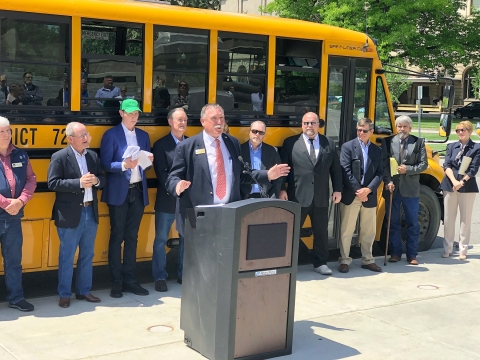
|
Commissioner Gordon Cruickshank (Valley County, Idaho) speaks on SRS reauthorization.
Resiliency, Transportation and Infrastructure
Support County Priorities in Any New Federal Infrastructure Package or Surface Transportation Reauthorization
BACKGROUND
Counties play a critical role in the nation’s transportation system, owning 45 percent of all public roads and building and maintaining 38 percent of the National Bridge Inventory. Counties operate 78 percent of all public transit agencies and 34 percent of public airports that connect residents, communities and businesses with the global economy.
In recent months, President Trump and congressional leaders have engaged in a series of meetings to develop a path forward for comprehensive infrastructure legislation. Following a series of meetings where the President and congressional leaders decided on a $2 trillion spending package, the issue of how to pay for this investment continues to be a sticking point on both sides of the aisle. Both the White House and Congress remain hopeful that negotiations can continue, and a package can be realized; however, lawmakers will soon need to turn their attention to a surface transportation reauthorization that will address the upcoming expiration of the current legislation.
The current authorization, Fixing America’s Surface Transportation (FAST) Act (P.L. 114–94), is set to expire in September 2020, leading the U.S. Senate Committee on Environment and Public Works (EPW) to develop and pass favorably out of committee on Tuesday, August 1 the most recent iteration of a bipartisan reauthorization, the America’s Transportation Infrastructure Act (ATIA). ATIA is a five-year, $287 billion spending package that, in its current form, outlines the highway title of the legislation. This number represents a roughly 27 percent increase over funding for highway programs from the FAST Act. The timing remains unclear on when the remaining three U.S. Senate committees of jurisdiction over surface transportation will act. Rail and transit titles will need to be added to the legislation by the U.S. Senate Committee on Commerce and the U.S. Senate Committee on Banking, respectively. The U.S. Senate Committee on Finance will also have to produce a “pay for” to cover the bill’s transfers from the general fund, in addition to addressing the impending insolvency of the Highway Trust Fund that is predicted to be bankrupt by 2021.
The administration has expressed its intent to work with Congress as members introduce infrastructure-related legislation, and it may become more likely that piecemeal legislation dealing with infrastructure investments, such as unlocking the Harbor Maintenance Trust Fund, uncapping airport passenger facility charges and the increasing and indexing to inflation of the federal motor fuel user fee, is considered instead of a larger, more comprehensive infrastructure package.
COUNTY INTEREST
As the 116th Congress considers proposals to update the nation’s transportation infrastructure systems, it is vital that federal policy makers recognize counties as major owners of infrastructure. Reliable federal investments through a new, long-term infrastructure package or surface transportation authorization, developed in consultation with federal, state and local partners, would allow counties to pursue much-needed infrastructure improvements and transformative surface transportation projects. Counties believe that a user-pay approach should continue to be the cornerstone of federal transportation funding and that federal policy should provide counties the flexibility to use additional financing tools. Such policies include:
- A strong federal-state-local partnership that enshrines local decision-making authority will be critical to delivering a bipartisan infrastructure package or surface transportation reauthorization that invests in every community across the country.
- While counties support public-private partnerships (P3s) for project development, it is important that any future infrastructure package provide funding to those parts of the country where private investment is not appropriate. Any new federal infrastructure package should include a robust rural infrastructure component and a sufficient funding match.
- Tax-exempt municipal bonds are a critical tool for counties to facilitate the budgeting and financing of long-range investments in infrastructure. Without the tax exemption, counties would pay more to raise capital, resulting in reduced spending on roads and bridges, decreased economic development, higher taxes or higher user fees. The Tax Cuts and Jobs Act (P.L. 115-97), signed into law in 2017, fully retained the tax-exempt status of all municipal bonds, and counties support the continued preservation of the tax-exempt status.
- To maintain a robust infrastructure network, the Highway Trust Fund must remain solvent. NACo advocates for an “all tools in the toolbox” approach that considers revenue sources that will better capture all users of the nation’s roads and account for all vehicles, including the increase and index to inflation of the federal motor fuel user fee.
- Counties support innovative financing mechanisms including, but not limited to: qualified tax credit bonds; infrastructure banks; the Transportation Infrastructure Finance and Innovation Act (TIFIA); and public-private partnerships that would allow local governments and transportation authorities, such as counties, to leverage federal financing for capital projects.
- Counties support a streamlining of the federal permitting process, in order to reduce project delays and associated costs that result from duplicative reviews and procedures, while still ensuring strong environmental stewardship.
STATUS
Federal lawmakers continue to express interest in working together to improve the state of our nation’s infrastructure. While funding continues to impede progress on a comprehensive infrastructure package, both sides of the aisle agree that increase investment in our nation’s infrastructure system is necessary. To this end, U.S. House Transportation and Infrastructure Committee Chairman Peter DeFazio (D-Ore.) has expressed interest in continuing talks with the White House. In May, Congressman Earl Blumenauer (D-Ore.) introduced legislation that would increase the federal motor fuel user fee and index it to inflation, a policy that counties strongly support. The legislation faces an uphill battle in the Republican-controlled Senate, however, where the majority is wary of raising taxes. Neither chamber has considered the bill to date.
Fiscal year (FY) 2020 appropriations for the U.S. Department of Transportation are currently being considered by the U.S. Senate following its passage in the U.S. House in late June. Should the Senate amend the House’s version, the two chambers will need to work out their differences in conference prior to sending it to the President for his signature.
The FAST Act is set to expire in September 2020, necessitating lawmakers turn their attention to the reauthorization and potentially away from pursuing a grander deal on infrastructure. Legislation from the Senate EPW Committee that would reauthorize funding for surface transportation programs is working its way to the Senate floor; however, it is expected that the chamber will take up spending bills prior to any action on ATIA upon returning from August recess. While EPW Chairman John Barrasso (R-Wyo.) is adamant that the current authorization should not be extended, it is likely that a short-term extension will be necessary due in large part to next year’s presidential election.
TALKING POINTS
Any new infrastructure legislation or administrative action should accomplish the following goals:
Allocate direct funding for locally owned infrastructure.
Preserve the tax-exempt status of municipal bonds.
Streamline the federal permitting process.
Implement policies to promote innovative financing.
Ensure the long-term certainty and solvency of the federal Highway Trust Fund.
TAKE ACTION
Urge your members of Congress to support county priorities in any new infrastructure package, particularly while Congress works on a long-term surface transportation infrastructure reauthorization bill.
RELEVANT COMMITTEES WITH JURISDICTION (FIND YOUR MEMBER)
- U.S. House Committee on Transportation and Infrastructure
- U.S. House Committee on Ways and Means
- U.S. Senate Committee on Environment and Public Works
- U.S. Senate Committee on Commerce, Science and Transportation
- U.S. Senate Committee on Banking, Housing and Urban Affairs
- U.S. Senate Committee on Finance
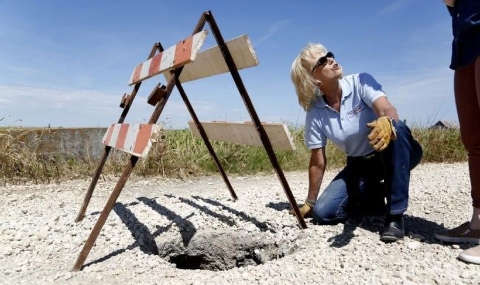
|
Commissioner Cindy Bobbitt (Grant County, Okla.) examines county bridge damage.
Support Federal Efforts to Improve the Accuracy of the Federal Communications Commission (FCC) Broadband Mapping Data
BACKGROUND
The accuracy of the Federal Communications Commission’s (FCC) National Broadband Map has become the target of bipartisan concern within Congress. Currently, the FCC requires Internet Service Providers (ISPs) to submit data indicating broadband availability and speed twice a year to determine network coverage and service levels. However, there is no mechanism to verify the accuracy of the data provided, leaving the potential for speed and availability to be significantly overstated.
The lack of competition also means customers fortunate enough to have service often pay some of the highest prices for broadband in the developed world. Anecdotal evidence suggests an entire ZIP code is oftentimes marked as “served” with broadband if just one home in the census block has coverage. As a result, the FCC routinely declares these markets connected and competitive when reality tells a very different story.
|
Download the TestIT app and help us identify areas with low or no connectivity to help ensure adequate funding for broadband infrastructure is provided across the country. |
COUNTY INTEREST
Access to affordable high-speed internet has been widely recognized as essential to one’s ability to compete in today’s economy. Accurate connectivity data is the foundation for investments in broadband infrastructure. Unfortunately, connectivity data provided to the FCC by internet service providers is often inaccurate and inflated – leaving many rural communities overlooked and disconnected.
Connectivity issues continue to plague counties across the United States. According to the FCC, approximately 19 million Americans — 6 percent of the population — lack access to even basic broadband services. Connectivity is imperative for economic competitiveness in the 21st century. From e-commerce and the gig economy to distance learning and tele-health facilities — county residents’ daily lives are increasingly reliant on a certain level of connectivity. As demand for access to affordable high-speed internet grows, economic opportunities for the unconnected continue to slip away. Counties lacking access to even basic broadband infrastructure are at a competitive disadvantage, exacerbating the economic divide between rural and urban areas.
STATUS
Several bipartisan bills have been introduced in the 116th Congress specifically addressing the failures of the FCC maps:
- Broadband Deployment Accuracy and Technological Availability (Broadband DATA) Act: Introduced by Senate Commerce Committee Chairman Roger Wicker (R-Miss), Senator John Thune (R-S.D.), Senator Amy Klobuchar (D-Minn.) and Senator Gary Peters (D-Mich.), this bill is aimed at improving the FCC’s broadband map by requiring more granular service availability data from wired, fixed wireless and satellite broadband providers. Additionally, the bill would instruct the FCC to consider collecting verified coverage data from state, local and tribal governments.
- Improving Broadband Mapping Accuracy Act (S. 842): Introduced by Senators Amy Klobuchar (D-Minn.), Shelley Moore Capito (R-W.V.), Joe Manchin (D-W.Va.) and John Hoeven (R-N.D.), this bill would direct the FCC to initiate a rulemaking to establish a process for using data reported by consumers and state, local and tribal government entities verifying coverage data reported by service providers.
- Broadband Data Improvement Act of 2019 (S. 1522): Introduced by Senators Shelley Moore Capito (R-W.Va.), Brian Schatz (D-Hawai‘i), Jerry Moran (R-Kan.) and Jon Tester (D-Mont.), this bill would require broadband providers to report service availability through GIS shapefiles, rather than larger census block level data. The GIS shapefiles would replace the current Form 477 process and provide a more accurate picture of connectivity at ground level. Additionally, this bill would establish a streamlined data validation process.
- Save the Internet Act of 2019 (H.R. 1644): The Save the Internet Act of 2019 recently passed the U.S. House of Representatives (232-190). Included in this package is an amendment written by Rep. Abigail Spanberger (D-Va.) that would require the Government Accountability Office (GAO) to examine the accuracy of the FCC’s broadband mapping. Additionally, the GAO report would provide recommendations on how the FCC could produce more accurate maps.
- Broadband Mapping After Public Scrutiny (MAPS) Act (H.R. 2643): Introduced by Representatives Bob Latta (R-Ohio) and Peter Welch (D-Vt.), this bill would require the FCC to establish rules for data submitted to the FCC by private entities and state, local and tribal government entities to verify fixed and mobile broadband service coverage data reported to the FCC by fixed and mobile broadband service providers.
In October 2018, NACo began work on an initiative aimed at addressing the FCC’s data disparities through a crowdsourcing platform. Partnering with the Local Initiatives Support Corporation, the Rural Community Assistance Partnership, the National Association of Development Organizations and Farm Credit, NACo released “TestIT” — a mobile app designed to identify areas with little or no connectivity. With TestIT, users can report their broadband speeds from anywhere with a simple click of a button. The data collected through this app will help identify areas where broadband service is overstated and underfunded by comparing the data to the FCC’s National Broadband Map.
TALKING POINTS
TAKE ACTION
Urge your members of Congress to support legislation aimed at improving the accuracy of the FCC’s broadband coverage maps, and encourage residents to download NACo’s TestIT app to help identify areas with little or no connectivity.
RELEVANT COMMITTEES WITH JURISDICTION (FIND YOUR MEMBER)
- U.S. House Committee on Energy & Commerce
- U.S. Senate Commerce, Science and Transportation Committee
Watch: Learn how to use our TestIT app to help identify areas with low or no connectivity to help ensure adequate funding for broadband infrastructure is provided across the country.
Preserve Local Zoning Authority in the Deployment on Next Generation Telecommunications
BACKGROUND
On September 26, 2018, the FCC approved a new rule on 5G wireless network deployment that significantly restricts local authority. The FCC decision not only limits fees local governments can assess telecommunications companies for the placement of wireless service facilities, but it also constrains local governments to 60 days to evaluate applications from wireless companies to attach 5G small cells to existing structures and 90 days to review applications for equipment on entirely new structures.
COUNTY INTEREST
By narrowing the window for evaluating 5G deployment applications, the FCC rule would prevent local governments from properly assessing and mitigating the impact broadcasting facilities may have on the public health, safety and welfare of the community.
5G deployment will require telecommunications providers to install hundreds of thousands of small cells across the country to construct 5G networks. Most of these sites are located on locally-owned, public rights-of-way, which requires providers to submit applications for local government review. The local review process is essential to ensuring small cell sites do not put public health and safety at risk during the construction and modification of broadcasting. Due to the significant number of small cell sites needed to fully deploy 5G, close coordination between wireless service providers and local governments is critical during the siting process.
5G’s reliance on a large network of small cell sites will place a considerable administrative strain on local governments’ ability to process the exponential increase in applications for small cells from service providers.

Next Generation Local Zoning Authority: 5G Wireless Broadband 101 |
STATUS
On June 2, 2019, Sen. John Thune (R-S.D.) and Sen. Brian Schatz (D-Hawaii) introduced legislation that would place limits on the authority of local governments to regulate the deployment of wireless communications infrastructure within our jurisdictions. The new legislation, titled the Streamlining the Rapid Evolution and Modernization of Leading-edge Infrastructure Necessary to Enhance Small Cell Deployment Act, or STREAMLINE Small Cell Deployment Act for short, would essentially codify the FCC’s recent ruling which is currently embattled in the 10th Circuit Court.
The bill goes one step further than the FCC ruling by enacting a “deemed granted” provision which would allow service providers to place small cells on public property without approval if local governments are unable to process applications within the 60 or 90 day windows.
Simultaneously, Senator Diane Feinstein (D-Calif.) and Congresswoman Anna Eshoo (D-CA18) have introduced companion legislation (S.2012 and H.R. 530 respectively) aimed at reversing the FCC’s recent ruling.
TALKING POINTS
TAKE ACTION
Urge your members of Congress to support and cosponsor the Accelerating Broadband Development by Empowering Local Communities Act of 2019 (H.R. 530) and the Restoring Local Control Over Public Infrastructure Act of 2019 (S. 2012) that would effectively rescind the FCC’s 5G order.
RELEVANT COMMITTEES WITH JURISDICTION (FIND YOUR MEMBER)
- U.S. House Committee on Energy and Commerce
- U.S. Senate Commerce, Science and Transportation Committee
Restore Advance Refunding Bonds to Support Infrastructure Development
BACKGROUND
Tax-exempt bonds are a well-established financing tool written into the first tax code in 1913. They are predominantly issued by state and local governments for governmental infrastructure and capital needs purposes, such as the construction or improvement of schools, streets, highways, hospitals, bridges, water and sewer systems, ports, airports and other public works.
Prior to 2017, advance refunding bonds were also tax-exempt. However, on December 23, 2017, President Trump signed the Tax Cuts and Jobs Act (P.L. 115-97), the first major rewrite of the tax code since 1986. While the final bill retained tax-exempt status for municipal bonds, it eliminated the tax-exempt status of advance refunding bonds.
COUNTY INTEREST
Advance refunding bonds, when tax exempt, allow counties to refinance municipal bonds once over the lifetime of the bond. By using advance refunding bonds, counties can lower borrowing costs and take advantage of more favorable interest rates. This saves county and taxpayer dollars on infrastructure development and frees up additional resources to be used for other important capital projects. Advance refunding bonds also allow localities to address problematic bond terms and conditions or to restructure debt service payments for budget flexibility.
Prior to their elimination, advance refunding bonds made up about a third of the municipal bond marketplace, with over $475 billion in advance refunding bonds issued between 2012 and 2017. Over that time frame, municipalities saved more than $14 billion of taxpayer money through this financing tool.
STATUS
In May 2019, a bipartisan group of legislators introduced the Investing in Our Communities Act (H.R. 2772) to restore the tax-exempt status of advance refunding bonds, allowing state and local governments to better respond to market conditions and reduce taxpayer burden. As Congress continues to work towards a comprehensive infrastructure package, restoring this important financial management tool is critical to future capital investments.
TALKING POINTS
TAKE ACTION
Urge your members of Congress to support H.R. 2772 to restore advance refunding bonds.
RELEVANT COMMITTEES WITH JURISDICTION (FIND YOUR MEMBER)
Support Reauthorization of the National Flood Insurance Program (NFIP)
BACKGROUND
The National Flood Insurance Program (NFIP) was created by Congress under the National Flood Insurance Act of 1968 (P.L. 90-448) to provide insurance coverage to property owners for damages and losses due to catastrophic flooding.
Today, NFIP is administered by the U.S. Department of Homeland Security (DHS) through the Federal Emergency Management Agency (FEMA). The program aims to reduce the impact of flooding on private and public structures by providing affordable insurance to property owners and encouraging communities to adopt and enforce floodplain management regulations.
NFIP was last reauthorized in 2012 when President Obama signed the Biggert-Waters Flood Insurance Reform Act of 2012 (P.L. 112-141). The purpose of the Biggert-Waters Act was to make the National Flood Insurance Program (NFIP), which faced a deficit of $24 billion, solvent. However, the Biggert-Waters Act resulted in some unintended consequences for local governments, residents and businesses.
Following the Biggert-Waters Act – several counties both coastal and inland – have reported that their homeowners and businesses faced drastic increases in annual NFIP flood insurance premiums due to phase-outs of subsidized premium rates. Additionally, because of the Biggert-Waters Act, FEMA began to update Flood Insurance Rate Maps (FIRMs), which included new low-lying areas that also began to face drastic rate increases.
In 2014, with NACo’s support, Congress passed the Homeowner Flood Insurance Affordability Act (P.L. 113-89), which included several key reforms to the Biggert-Waters Act that were favorable to counties, including grandfathering of premiums for properties built to code prior to the release of Flood Insurance Rate Maps (FIRMs), retroactive refunds to NFIP policyholders if they paid a higher premium under Biggert-Waters and the removal of a sales trigger that fully actualized premium rates at the point of sale for properties that were added to new flood zones.
The 2012 NFIP reauthorization ended on September 30, 2017, and since then the program has been funded by a series of short-term funding measures. The current extension expires September 30, 2019.
COUNTY INTEREST
Local governments play a key role in NFIP. While making land use and development decisions, counties must recognize and incorporate flood hazards during the decision-making process. For residents to be eligible to participate in NFIP, local governments must comply with NFIP policies when setting and enforcing building codes, approving building permits, regulating water quality and building and maintaining public infrastructure.
Additionally, counties are responsible for addressing public health and safety issues when disasters strike. When a hurricane hits or flooding occurs, county emergency managers are often first on the scene, coordinating emergency management efforts and working to mitigate damage before and after disasters. Along with providing a flood insurance, NFIP aids local governments as they prepare for natural disasters by allocating funds to develop emergency management and mitigation plans for future flooding events.
STATUS
Currently the U.S. House of Representatives is considering H.R. 3167, which has cleared the House Financial Services Committee on a bipartisan 59-0 vote. Along with reauthorizing the program for five-years, the legislation would make key reforms to enhance and modernize NFIP. Provisions within the bill supported by NACo include:
- Creating a five-year pilot program to provide means-tested assistance for low-income policy holders
- Providing $500 million annually for updates to mapping technology to better predict future flood risk
- Allocating $200 million annually for the flood mitigation assistance grant program
- Authorizing monthly premium payments to ensure low-income policy holders can afford flood insurance
- Providing continuous coverage for policy holders who wish to explore flood insurance in the private market
The committee also approved H.R. 3111, which would make reforms to the NFIPs program management and address consumer protection concerns.
TALKING POINTS
TAKE ACTION
Urge your members of Congress to support legislation that will reauthorize NFIP and develop policies that will allow participation from the most vulnerable county residents. This includes improving premiums rate affordability for low income and high risk residents, and funding for state and local governments to invest in mitigation measures that will help to protect lives and property.
RELEVANT COMMITTEES WITH JURISDICTION (FIND YOUR MEMBER)
- U.S. House Committee on Financial Services
- U.S. Senate Committee on Housing, Banking and Urban Affairs
|
|
NACo’s Gulf State Counties and Parishes Caucus meeting in Gulf Shores, Al.
Regulatory Actions
Preserve County Interests in Waters Of The U.S. (WOTUS) Regulations
BACKGROUND
Waters of the U.S. (WOTUS) is a term used in the Clean Water Act (CWA) to determine what waters and their conveyances fall under federal verses state permitting authority. In 2014, under the Obama Administration, the Environmental Protection Agency (EPA) and the U.S. Army Corps of Engineers (Army Corps) undertook an effort to rewrite and expand the WOTUS definition, which had not been altered since 1986. The Obama Administration finalized a controversial new definition in 2015.
NACo expressed concerns about how the broader 2015 rule would impact construction and maintenance on county-owned and maintained roads and roadside ditches, bridges, flood control channels, drainage conveyances and wastewater and stormwater systems. Ultimately, the rule was challenged in the courts. As a result, the 2015 rule is valid in 22 states and the 1986 regulations are the rule of law in 28 states.
In February 2019, the EPA and the Army Corps officially released a new proposed WOTUS definition, which is expected to be finalized in December 2019.
COUNTY INTEREST
As owners, users and regulators of water resources and infrastructure, counties are directly impacted by the definition of WOTUS. Counties expressed concerns with the 2015 rule, highlighting the impact a broader interpretation of WOTUS could have on county-owned infrastructure. Counties own and maintain roads and roadside ditches, bridges, flood control channels, drainage conveyances and wastewater and storm water systems, and act as both regulators and regulated entities under the CWA. A more expansive WOTUS definition could prove too costly and burdensome for counties to comply.
STATUS
On February 14, 2019, EPA and the Army Corps proposed a new definition for WOTUS. The public comment period closed on April 15. NACo submitted two sets of comment letters. The first letter, with the National League of Cities and the U.S. Conference of Mayors, highlighted the opportunities and challenges that counties, cities and mayors potentially face. The second letter was exclusively focused on counties and went into greater detail on how the rule could potentially impact county-owned infrastructure. In its comments, NACo stressed the following:
In addition, NACo offered the following recommendations to the agencies:
- Draw a clear distinction between natural streams and manmade ditches intended for public safety;
- Clarify the status of the current ditch maintenance exemption in the pending WOTUS rule;
- Further define the term “intermittent,” including how the agencies would interact with state and local governments to develop regional definitions
- Clarify exemptions for stormwater features and wastewater recycling structures constructed in uplands and
- Develop a nationwide WOTUS map.
TALKING POINTS
RELEVANT COMMITTEES WITH JURISDICTION (FIND YOUR MEMBER)
- U.S. House Committee on Transportation and Infrastructure
- U.S. Senate Committee on Environment and Public Works

|
County leaders tour the Grand Coulee Dam at the 2019 Western Interstate Region Conference.
Additional Resources
Media Toolkit
While members of Congress are in their states and districts during the summer and fall district work periods, county officials have a great opportunity to draw attention to key federal policy issues that impact your county. In addition to inviting your members of Congress for an in-person tour or meeting, your local media outlets are another key advocacy tool. They provide a useful way to keep your residents informed about what you are doing on their behalf.
There are many ways to work with your local media, including issuing a press release to inform your community about a congressional visit to your county projects and facilities. Submitting an op-ed or a guest commentary to local papers is also an excellent way to express your views in a highly visible way. To assist you, NACo has developed a Media Relations Guide for Countiesâ that provides tools and tips on how to best work with local media outlets.
|
|
